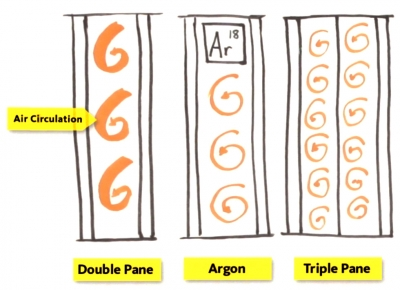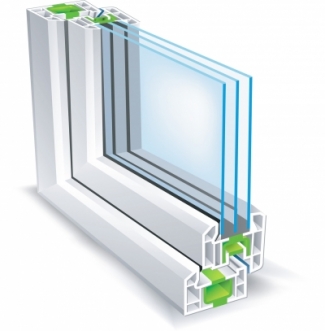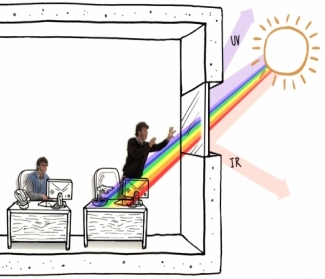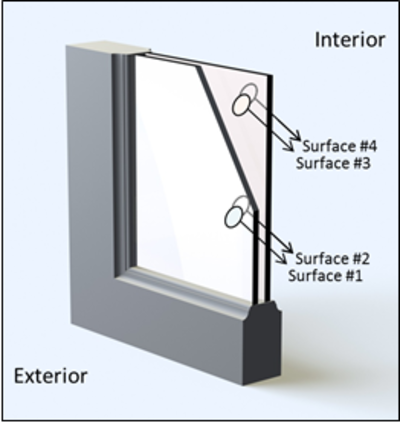You are here
Window configurations that use low-E coatings, selective transmission films, inert gas fills, and thermal breaks can lead to higher energy performance. The net effect of these measures is to reduce the U-factor, and the right choice of these features depends on the application.
 |
| Window constructions with air gaps and inert gasses to reduce convection between window panes |
Air Gaps and Inert Gases
U-values can be decreased by reducing the convection within the glazing unit. The simplest way to do this is to subdivide the air space by adding more panes. Interior panes are often merely thin films, since only the outer panes need to be structural materials like glass.
Air between panes can be replaced by denser gases like Argon or Krypton, which both reduce conduction and convection. Filling an enclosed air space with argon or krypton has thermal benefits. These less-conductive gases greatly reduce heat transfer by convective currents, producing lower U-factors. As a result, the inner surface of the glass is maintained at a temperature closer to that of the indoors, with greater comfort (because radiant heat flow to or from the window surface is reduced) and less chance of condensation on the inside surface. To preserve this gas fill over the life of the window, a very reliable edge seal is required.
Some constructions fill the space between panes with cellular materials or batting to reduce convection, though these units are no longer transparent, so they can no longer be used for views.
Low-Emittance (low-E) Coatings
What are Low-E Coatings
The performance of windows and skylights can often be improved by using Low-Emittance (low-E) coatings on their glazing surfaces.
- Hard-coat : durable, less expensive but less thermally effective
- Soft-coat : better thermal performance but more expensive and subject to degradation by oxidation in the manufacturing stage
These coatings are typically applied to one glass surface facing into the air gap between multiple glazings. A low-E coating blocks a great deal of the radiant transfer between the glazing panes, reducing the overall flow of heat through the window and thus improving the U-factor. Indeed, one such coating is almost as effective as adding another layer of glazing. An important added benefit of these films is their reduction of UV transmission, thus reducing fading of objects and surface finishes in rooms.
Low-E Coating Configurations and Heat Transfer
Low-E coating glass works like a thermal mirror with the low-E material on the back of the pane that reflects the heat radiation. The surface that is treated by the low-E coating material is selected based on the climate.
In multi-pane windows, thermal radiation from warmer pane to other pane is the main mechanism of heat flow. By applying low-emittance material to the interior or exterior pane, depending on the side that heat is meant to be kept, a significant amount of radiant heat transfer is blocked.
Three common types of low-E coatings are:
1) High-transmission low-E: In heating-dominated climates where you want to block heat radiation from inside, the low-E coating should be deposited on the outer surface of the interior pane of glass (surface #3). This is good for passive solar heating applications, where a low U-factor is combined with a high SHGC. In this case the coating traps outgoing infrared radiation that otherwise would be lost. Summer overheating can be avoided with external shading devices.
2. Selective-transmission low-E: Where winter heating and summer cooling are both important, requiring low U-factor and low SHGC, but with a relatively high VT for day lighting. The coating is on the outer glazing, where it blocks incoming infrared radiation, which as heat is then convected away by outdoor air.
3. Low-transmission low-E: In cooling dominated climates, where the sun is the enemy, low U-factor, low SHGC, and even low VT seem warranted. Again the low-E coating is placed on the outer glazing, where it rejects more of the solar gain. With a tinted exterior glazing, even lower SHGC and VLT could result.
Note that the exact placement of the low-E material is not as critical as using low-E materials in the first place.
The following table shows the U-values for various glazing constructions. As it can be seen, adding low-E coating improves the U-Factor (see Glazing Properties) of the window which results in better performance.
| Glazing Type | U-value | |
| W/m2K | BTU/(h℉ ft2) | |
| Single pane | 4.8 | 0.85 |
| Double pane, air filled | 2.5 | 0.49 |
| Double pane, low-E | 2.1 | 0.37 |
| Triple pane | 2.1 | 0.37 |
| Triple pane, low-E | 1.4 | 0.25 |
 |
|
Thermally-broken window frame |
Thermal breaks
U-values can also be reduced by reducing the conductivity of the materials in the glazing unit. As mentioned above, denser gases like Argon conduct less heat than air. More significantly, the window frame should not conduct heat around the glass.
Metal framing should be "thermally broken" to separate interior metal elements from exterior elements. Wood or fiberglass conducts much less heat than metal window frames. The framing of windows and other glazing can cause so much heat loss that a unit's overall U-value may be double or triple the "center of glass" U-value. Thus it is important to use U-values that include framing.
 |
|
Spectrally selective windows can block certain wavelengths of light |
Selective Transmission Films
You can also control which wavelengths of light that you transmit into the space. "Spectrally selective" windows allow visible light in while blocking most other wavelengths, such as infrared and/or ultraviolet. They have a high Tvis without a high total light transmission. Ultraviolet light can fade and otherwise deteriorate interior finishes and furnishings. Infrared light is heat, and is often undesirable in warm climates.
Spectrally selective windows can block certain wavelengths of light
These films admit most of the incoming solar radiation in both the visible and near-infrared (short) wavelengths. Warm objects within a room emit far-infrared (long-wave) radiation. This long-wave radiation is reflected back into the room by the selective film.
These selective films typically are available as separate sheets that can be inserted between sheets of glazing as a window is fabricated. As a separate sheet, a selective film could also be applied to existing windows—for instance, between storm windows and the ordinary windows they protect.



